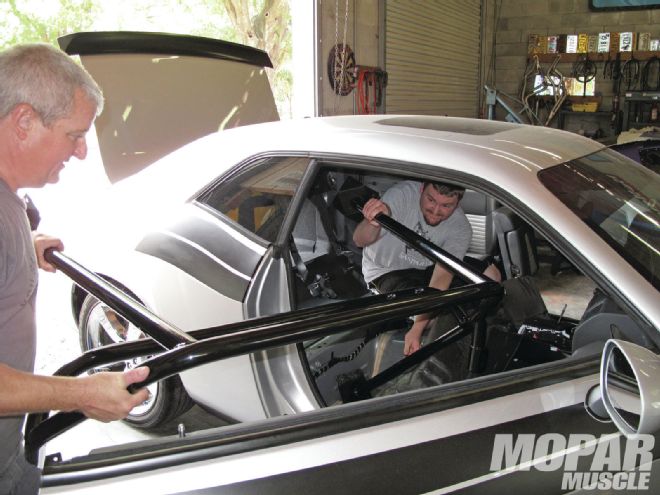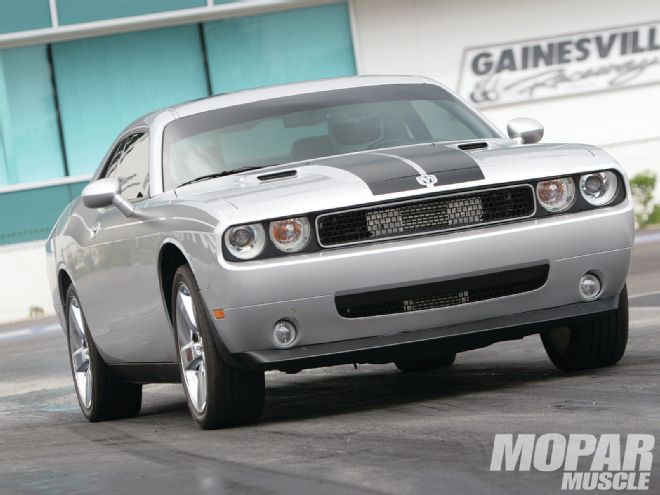
The Chrysler Corporation has a long history of producing some of the best class-legal racecars of any auto manufacturer, designing cars and powerplants with the purpose of drag and circle track domination. And while most of us remember the famous Dodge and Plymouth racecars of the sixties and seventies, were you aware that the new Dodge Challenger in drag-pack form is specifically designed for the Stock and Super Stock classes of drag racing? And even if your Challenger is simply a fast street car or sees street/strip duty, there are important safety items, such as a roll bar, that should be considered in the interest of safety and chassis stiffness.
While most of us think of a roll bar as an item reserved for dedicated race cars, there are many reasons to consider installing one in your Challenger street or street/strip vehicle. Even in stock form, the Challenger R/T or SRT-8 models are capable of speeds in excess of 150 mph, which is fast enough to cause major damage in the case of an accident. And while these cars incorporate the latest construction techniques and passenger protection devices to enhance safety, in the case of a rollover accident, a roll bar gives additional protection to the car’s driver and passenger, and can be the difference between major injuries or walking away with scratches. Additionally, sanctioning bodies generally require a roll bar for any car quicker than 11.50 in the quarter mile, so if you want to race your modified Challenger, you may be required to install a roll bar.
As we modify our 2009 Dodge Challenger R/T, our goal is to eventually install a Hemi with significantly more power than the stock ProCharged unit in the car now. Already pushing the twelve second range, we’re pretty sure our planned engine will propel our car to sub-twelve second times, and we also figured the enhanced safety was a good idea no matter how quick our car is. Another benefit of a roll bar is it can greatly add to chassis stiffness by connecting the LX’s unibody platform in key areas like the floor in front of the rear frame rails and the rear wheelwells.
After deciding to install a roll bar, we needed to decide whether we wanted a custom, welded in roll bar or cage, or if a removable roll bar would suit our needs. A little research on the internet let us to RPM Rollbars, a division of M & H Engineering, who offers pre-built, bolt-in roll bar kits for the new Dodge Challenger. Since this car is used for cruising, transportation, and a little racing, we decided the option of removing the roll bar for normal driving sounded desirable. Additionally, if we ever decide to sell our vehicle, a potential buyer may not want or need a roll bar, so a bolt-in bar will allow us to easily put our car back in stock form if necessary.
The RPM roll bar is a 5-point system, with a main roll bar, two down-bars to the rear wheel wells, and a door bar on the driver’s side. This bar is NHRA approved and legal for cars running elapsed times from 11.49 seconds all the way down to 10 seconds flat. In fact, RPM guarantees your car will pass tech with this bar or, as their website says, they will buy the roll bar back. We decided that in the interest of adding the least amount of weight to our car as possible, the chrome-moly bar would be ideal for us. This roll bar adds only 45 pounds to the car, as opposed to the mild steel roll bar which weighs in at 75 pounds.
Specially designed on CAD equipment, all RPM Rollbars are mandrel bent, and welded robotically for strength and appearance. The bar is completely bolt-in, and the only required modifications required are drilling holes in the car’s floor and wheel-wells for the attaching hardware. The door bar is NHRA legal as well, and is a swing-out style for easy ingress and egress. When installed, the bar fits tightly against the headliner and door panels, blending well with the lines of the car, and the front seats retain all but their full recline adjustability. Our chrome-moly roll bar was in the standard finish with industrial clear coat, and we chose black to match our car’s interior. Custom finishes are available as well, and too numerous to list here, so check them out on RPM’s website, www.rpmrollbar.com.
Installing the roll bar involves removing the front seats, rear seat, and console, as well as the door sill plates. The carpet can be moved out of the way to drill holes, and then cut and put back in place around the bars. Working with the help of former Associate Editor Kevin Diossi, we had the bar installed in about six and a half hours, but plan a full day or weekend if you haven’t performed this type of work before. The price for our chrome-moly roll bar is $1,995.00, and the slightly heavier mild-steel roll bar retails for $1,195.00 at the time of this writing. We hope to never need to use this bar, except for the chassis stiffening it offers, but in the unfortunate event of an accident we consider the money well spent for the extra protection offered by the RPM roll bar.
 <STRONG>1</STRONG> Whether you drive your Mopar on the street, track, or a combination of the two, a rollbar adds chassis stiffness and additional safety in the unfortunate event of an accident.
<STRONG>1</STRONG> Whether you drive your Mopar on the street, track, or a combination of the two, a rollbar adds chassis stiffness and additional safety in the unfortunate event of an accident.